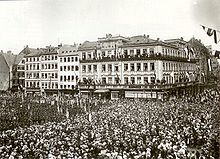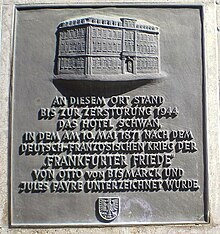Hotel to the swan

The Hotel [zum] Schwan was a famous hotel in Frankfurt am Main . It existed from 1592 to 1919. Its building from 1791 in Steinweg was destroyed by aerial bombs during the air raids on Frankfurt am Main in 1944. In its place there was later a cinema and today the Hugendubel bookstore .
In the 19th century in particular, the swan was a luxury hotel of European standing. It was of particular historical importance as the place where the Peace of Frankfurt was signed , which ended the Franco-German War here on May 10, 1871 .
The swan in classicist Frankfurt
The house Zum Weißen Schwan in Steinweg was mentioned for the first time in 1371. From 1592 it served as an inn.
In 1791 the hotelier Jacob Fay had the swan and the two adjacent buildings demolished and a new building built in the classical style. The hotel with its 150 beds soon became the most prestigious quarter in Frankfurt. In 1793, Princess Luise of Mecklenburg-Strelitz , who later became Queen Louise, celebrated her engagement to the Prussian Crown Prince Friedrich Wilhelm III. Other famous guests in the Swan were the French Emperor Napoléon Bonaparte , the Prussian General Blücher and the American writer James Fenimore Cooper .
The society at the table d'hote , which offered no less than eight courses a day , was made up of the most varied of circles, from bankers to academics, theater artists to cranky owls. Ludwig Börne parodied this society in 1827 in his satire The Fool in the White Swan , and Wilhelm Hauff described in his communications from the memoirs of Satan , published in 1826 , how Satan “lived quite well at No. 45 in the White Swan [and] at the big one Table d'hôte dined splendidly in pleasant company. "
A well-known original of that time was the head waiter people : He mastered six languages fluently, all served up to 200 guests of the board personally and knew at the end during registration without ever something to write down everyone's bill from the head.
Conversion to the world city hotel of the 19th century
In 1831 the swan was modernized. In addition to a new dining room with a monumental ceiling painting, it was one of the first houses in Frankfurt to receive gas lighting . The philosopher Arthur Schopenhauer , who lived in Frankfurt from 1832 until his death in 1860, was one of the regular lunchtime guests in the first-class Frankfurt inns . In the first few years he mainly visited the Russischer Hof , later the Swan , then the Englischer Hof on Roßmarkt and finally the Weidenbusch in Steinweg.
The Peace of Frankfurt
On May 10, 1871, the German Chancellor Otto von Bismarck met with the Foreign Minister of the French Republic , Jules Favre . At 2:15 p.m. the peace treaty was signed. "It is a nice thought to me that the first major political act of the resurrected German Empire could take place in Frankfurt, the old imperial and coronation city." In fact, it was a clever move by Bismarck, whose policy was five years earlier had led to the annexation of the Free City of Frankfurt in order to be reconciled with the city that he had disparaged as a Liberal Nest . His plan worked: under the impression of the solemn state act, the citizens of Frankfurt also made peace with him and cheered him on the evening of May 10, 1871. The so-called "Peace Room" was never rented out afterwards.
The last few years of the hotel
At the end of the 19th century, the traditional hotel experienced a gradual loss of importance, especially under the impression of competition from the newly opened large hotels such as the Frankfurter Hof .
They tried to stop this loss of importance through high-quality shops. In the building, for example, the hat shop of the purveyor to the court, Gustav Kramer, opened, whose son, the architect Ferdinand Kramer, later redesigned the rooms. The renovations carried out by Simon Ravenstein in 1906/07 also included a movie theater, but with the end of the First World War , the tradition finally came to an end.
In 1919 the swan was converted into a commercial building. The U.T. cinema was on the ground floor. set up in the swan . The Peace Room from 1871 remained open to the public. In 1935 his furniture was brought to the Historical Museum . It survived the bombing war while the swan was destroyed in 1944.
After the destruction
In 1949, the architects Alois Giefer and Hermann Mäckler built a commercial building and cinema on the former site of the destroyed hotel . The Metro im Schwan opened on December 21, 1949, followed by the Bambi cinema in 1954 and the Palette cinema in 1967 . At the end of the 1970s, three small cinemas ( Metro 2-4 ) were set up. In 1989 the cinemas moved out and the building was converted into the Hugendubel book store.
Guests (selection)
- Maria Theresia Paradis , blind composer, singer, pianist, music teacher - September 1785
- Robert Schumann , composer and music writer - 1829 (on his trip to Heidelberg) and 1830 (when visiting a concert by Niccolo Paganini)
- Willibald Alexis , writer
- Niccolo Paganini , an important Italian violin virtuoso
Web links
Individual evidence
- ↑ Wilhelm Hauff , Who Satan saw at the table d'hote in the White Swan (1826)
- ^ Johann Peter Eckermann , letter to Johann Wolfgang Goethe dated April 24, 1830
- ↑ Henning Roet de Rouet: Frankfurt am Main as a Prussian garrison from 1866 to 1914. Frankfurt am Main 2016, ISBN 978-3-95542-227-1 , p. 107 ff.
- ↑ Thomas Zeller, Monument Office of the City of Frankfurt am Main (ed.): The architects and their building activities in Frankfurt am Main from 1870 to 1950. Frankfurt am Main 2004, p. 294 f., ISBN 3-921606-51-9 , p 285.
- ↑ Hilmar Hoffmann , Walter Schobert (Ed.): Living pictures of a city. Cinema and film in Frankfurt am Main. Frankfurt am Main 1995, ISBN 3-88799-050-1 , p. 278 f.
Coordinates: 50 ° 6 ′ 49 ″ N , 8 ° 40 ′ 38 ″ E

